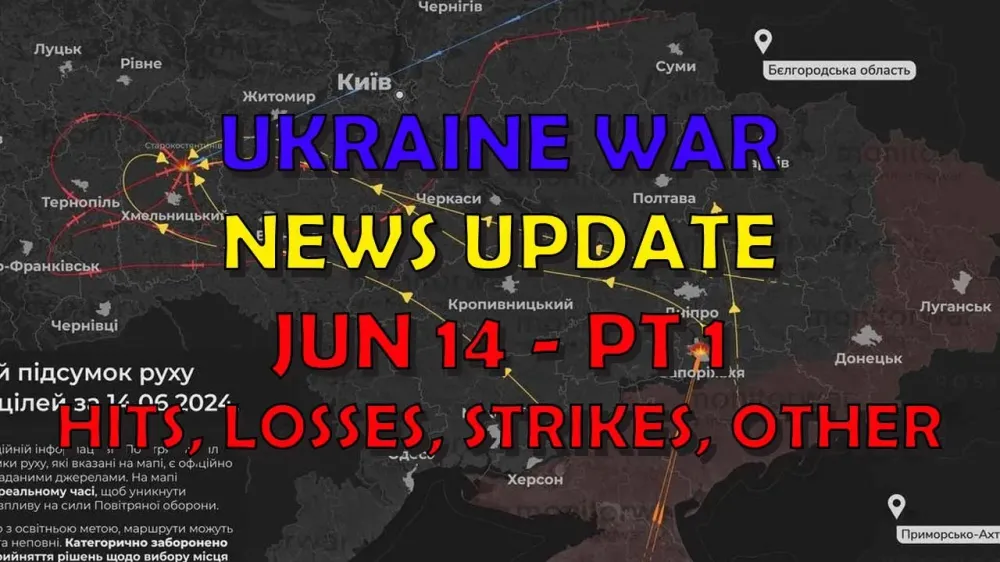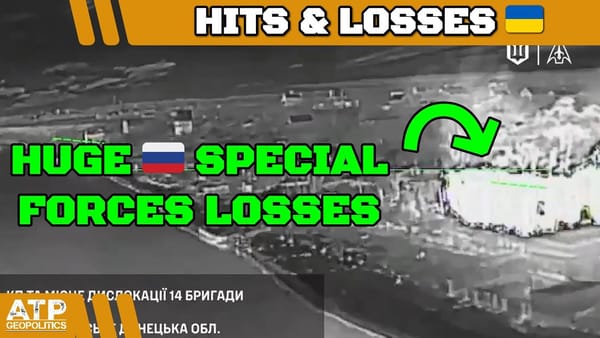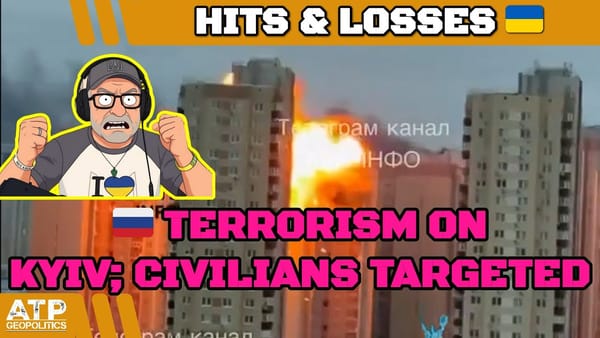Ukraine War Update NEWS: Pt 1 - Overnight & Other News
Table of Contents 📖
"They are moving their S-500, the one S-500, to Crimea. How desperate do they have to be? Really desperate."
Hello Team
🎦 00:00-01:00⏩
Jonathan welcomes viewers to another ATP Geopolitics update, preparing for an upcoming talk in North Hampshire. He's concerned about boring the audience and hopes for a good turnout. Jonathan also mentions his struggles with multiple sclerosis, particularly its impact on his memory and ability to recall names.
Return to top⤴️
🪦 DISCLAIMER FOR GENERAL STAFF LOSSES DATA
- These are real people with real lives and real families who love them. Don’t let the numbers sap your humanity.
- These numbers probably aren’t accurate but they’re the best we have and we don’t need them to be accurate to be indicative of patterns of activity.
- All losses are estimates. Losses cannot be counted with accuracy because of the conditions on the ground.
- Both sides would see it to be of their advantage to minimize their own losses maximize the other side’s losses.
- Neither side releases their losses but we have enough transparency from the Ukrainian side to have confidence in they are indicative.
- Personnel losses are hard to count. If a soldier gets injured, heals up, and returns to the front line only to get injured again, is that one loss or two? Also, how to deal with losses from PMC’s or soldiers fighting with RF from occupied territories?
- Equipment losses are hard to count. If an AA complex involves several parts and one part gets disabled, is that a loss, or a fraction of a loss? If a tank gets disabled, repaired, back into the fight, then disabled again, is that one lost tank or two?
- All recorded losses are vulnerable to multiple reporting. We have already seen numerous cases of multiple drones in the air reporting the same loss from different angles as multiple engagements.
- Losses are not always reported on the same day they occurred. It is frequent that drone losses are reported at least 24 hours after other terrestrial equipment losses. Certain losses may not be reported for days or weeks for military intelligence reasons.
Russian Losses
🎦 01:00-03:01⏩
- Jonathan analyses the latest figures from the Ukrainian General Staff. He notes the significant increase in Russian personnel losses, reaching 1,250 – a number not seen since the start of the Kharkiv counteroffensive.
- He connects this to potential renewed Russian offensive efforts near Vovchansk, highlighting the devastating destruction the town has suffered.
- Jonathan emphasises the substantial equipment losses, with eight tanks, 26 armoured personnel vehicles, and 48 artillery systems destroyed, exceeding average daily losses.
- He also mentions the loss of 60 vehicles and fuel tanks, signifying a considerable logistical blow.
Russian Tank Losses
🎦 03:01-05:12⏩
- Citing Oryx figures, Jonathan discusses the estimated 80% depletion of Russia's pre-war active tank fleet. He believes this to be a conservative estimate, suggesting that teams like Andrew Perpetua's likely have more accurate, higher figures.
- While Russia has dipped into its vast reserves, Jonathan argues that active tank numbers are likely lower now than at the war's outset. He details specific losses: over 100 T-80BVUs (including reactivated units), 97 T-90s, 200 T-80BVs (2022 variant), and 152 T-80s.
Russian Casualties and Treatment of War Dead
🎦 05:12-06:59⏩
Jonathan addresses anecdotal evidence of high Russian casualties from a video showing numerous graves in a Belgorod military cemetery. He points out the low recovery rate of Russian soldiers' bodies, attributing it to financial incentives: recovering, identifying, and returning bodies to families for compensation is costly, whereas listing them as missing is cheaper for the Russian MOD. He highlights the grim reality of battlefield conditions based on footage showing uncollected bodies.
Return to top⤴️
NATO Assessment of Russian Losses in Kharkiv
🎦 06:59-08:29⏩
Jonathan cites reports from Kyiv Independent and European Pravda, both referencing a NATO source, stating "astronomical" Russian losses during their Kharkiv offensive. He analyses Ukrainian General Staff data, noting a significant increase in Russian losses since their May 10th offensive in Kharkiv, with daily figures remaining consistently high. He compares current daily losses (around 980) with past figures, where 980 would have been considered the upper end, whereas now figures as high as 1,780 are being recorded.
Return to top⤴️
Russian Offensive in Hayarivka
🎦 07:53-09:14⏩
- Shifting focus to the Donbas region, Jonathan recounts reports of a failed Russian attack on Ukrainian positions in Hayarivka (near Marinka) involving 19 vehicles, of which 14 were destroyed.
- He finds this significant because it contrasts with the trend of smaller Russian attacks involving only a handful of vehicles, suggesting a return to larger-scale assaults, possibly after a period of stockpiling.
- However, even with greater numbers, they suffered heavy losses (75%), likely due to Ukrainian drone attacks.
Ukrainian Strike on Russian S-400 in Crimea
🎦 09:14-10:05⏩
Jonathan details a Ukrainian strike on an S-400 Triumph air defence system in Crimea's Bakhchysarai district. The attack reportedly destroyed the radar, generator, tractor, and a launch unit.
Return to top⤴️
Vulnerability of Sevastopol and Russian Deployment of S-500
🎦 10:05-12:13⏩
- With the recent strikes, Jonathan believes Ukraine has an opportunity to target Sevastopol, Crimea's main port.
- He suggests striking the remaining ships and military installations now that the surrounding air defences are weakened.
- However, Russia has responded by deploying its sole S-500 air defence system, previously stationed in Moscow, to Crimea.
- Jonathan interprets this as a sign of desperation, highlighting Russia's fear of losing Crimea and the symbolic blow it would represent.
Explosions in Belgorod, Russia
🎦 12:37-13:20⏩
Jonathan reports on an explosion in Shebekino, Belgorod Oblast, involving a Russian TOS-1A thermobaric rocket launcher. The explosion resulted in the death of three Russian servicemen and damage to nearby houses and vehicles. While unclear if the incident was a result of Ukrainian action or an accident, it highlights the risks posed by such volatile munitions.
Return to top⤴️
Ukrainian Bradley Commander Praises Vehicle
🎦 13:20-16:23⏩
- Jonathan highlights a Washington Post interview with a Ukrainian Bradley commander (identified only as "Victor") who praised the vehicle's performance and the training he received from US troops in Germany.
- Victor lauded the Bradley's armour, TOW missiles, and 25mm Bushmaster cannon.
- This praise, according to Jonathan, underscores the importance of such Western equipment in the conflict.
- He revisits his previous stance on supplying large numbers of Bradleys to Ukraine, noting the logistical and training challenges they present.
- Instead, he suggests a more sustainable approach: a steady flow of Bradleys to replace losses and gradually increase Ukrainian capacity.
Bradleys vs. Tanks in Ukraine
🎦 16:07-16:23⏩
- Jonathan argues that, given the current circumstances, Bradleys might be more valuable than tanks for Ukraine. He points to their mobility, firepower (TOW missiles and autocannons), and superior performance against older Russian equipment.
- He draws parallels to the effectiveness of HIMARS against Russian S-400 systems.
- Jonathan acknowledges this is a controversial view but stands by the assessment of the Bradley's utility in this specific context.
Russian Propagandists Injured and Killed in Horlivka
🎦 16:23-17:47⏩
- Jonathan reports on three Russian NTV journalists (propagandists) coming under fire in Horlivka, Donetsk Oblast.
- Initial reports indicated one fatality and two critically injured, but later updates confirmed the death of propagandist Vero Kozhin.
- Jonathan notes that this isn't an isolated incident, as Russia has lost several journalists due to their practice of embedding propagandists within combat units to shape the narrative.
Fire at Sukhoi Design Bureau in Moscow
🎦 17:47-19:04⏩
- Jonathan reports on a fire at the Sukhoi design bureau in Moscow.
- While the immediate impact on the war effort is likely minimal, he argues that such incidents have a significant psychological effect.
- For Moscow residents, it showcases their vulnerability and the potential for the war to reach them.
- He believes that damaging such institutions, likely through sabotage, serves a strategic purpose for Ukraine by impacting morale and potentially swaying public opinion against the war.
Overnight Strikes and Missile Interceptions
🎦 19:04-22:00⏩
- Jonathan moves on to overnight strikes, starting with explosions in Zaporizhzhia followed by three Iskander ballistic missile strikes and ten further missiles launched from Russian aircraft.
- He notes attacks on civilian targets in Sumy and Kharkiv regions using FPV drones, lamenting their use against passenger buses and highlighting the civilian casualties inflicted.
- Regarding missile interceptions, he reports that 7 out of 10 Kh-101/Kh-555 cruise missiles were intercepted (70% success rate).
- However, he questions the low number of cruise missiles used, contrasting it with the large-scale barrages seen earlier in the war.
- Jonathan suggests this indicates a potential depletion of missile stockpiles or logistical challenges in launching coordinated attacks.
Missile and Drone Interceptions: Breakdown and Analysis
🎦 22:00-23:19⏩
- Jonathan details further missile interceptions: 0 out of 3 Iskander-M ballistic missiles, 0 out of 1 KH-47M2 Kinzhal hypersonic missile, and 17 out of 17 Shahed drones.
- He analyses the targets, noting that most of the missiles and drones (excluding one that likely landed in Poltava) appear to have targeted Starokostyantyniv.
- Jonathan suggests that Russia's focus on Starokostyantyniv is likely due to its airbase, which houses Ukrainian Su-24M bombers and is a potential location for future F-16 deployments.
- He discusses the challenges and potential advantages of Russia's laser focus on one location, suggesting Ukraine could concentrate its defensive resources and develop countermeasures.
Ukrainian Drone Strikes on Russia
🎦 24:47-27:14⏩
- Jonathan shifts focus to Ukrainian drone attacks on Russia, starting with Russian claims of shooting down 87 drones.
- He expresses skepticism about this figure, suggesting the actual number of drones that penetrated Russian airspace is likely higher.
- He breaks down the Russian claims: 70 drones shot down in Rostov, 6 in Kursk, 6 in Voronezh, 2 in Belgorod, 2 in Volgograd, and 1 in Crimea.
- Jonathan focuses on the Rostov region, noting its proximity to Ukraine and the presence of valuable targets.
- He analyses footage and reports, concluding that while some damage is evident (particularly to an electrical substation in Morozovsk, resulting in power outages), it's unclear if all drones were intercepted.
Ukrainian Drone Strike on Kalino Air Base (Kursk)
🎦 27:14-28:10⏩
Jonathan reports on a Ukrainian drone attack on the Kalino Air Base in Kursk, believed to house a Shahed-136 drone warehouse. Residents reported explosions and power outages in the vicinity.
Return to top⤴️
Confirmation of Strikes and Damage from Previous Drone Attacks
🎦 28:10-29:41⏩
- Jonathan highlights the delayed confirmation of successful Ukrainian drone strikes, citing an example from previous days where a drone was filmed being shot down over Yaroslavl Oblast by a Russian Su-30SM fighter jet.
- He acknowledges that Russian air defences are effective but reiterates his point that they often overstate their success rate.
Ukrainian Energy Infrastructure and Blackouts
🎦 30:25-33:07⏩
- Jonathan discusses the dire state of Ukraine's energy infrastructure, with citizens facing up to 20 hours of daily blackouts under worst-case scenarios.
- He critiques the West's approach, arguing that a greater focus on military aid, particularly air defence systems, would have prevented the need for costly reconstruction efforts.
- Jonathan believes the recent shift in Western support towards increased military assistance stems from this realization.
- He highlights President Biden's reported commitment to prioritize sending all newly manufactured Patriot missile systems to Ukraine.
Ukrainian Labour Shortage and Migrant Workers
🎦 33:07-34:47⏩
- Jonathan addresses the labour shortage in Ukraine, with the construction sector hit particularly hard (40% worker shortage).
- He attributes this to the mobilization of men aged 25-60, leading to a decline in the available workforce.
- To compensate, Ukraine has started attracting migrant workers from countries like Pakistan, Nepal, India, Bangladesh, the Philippines, and African nations.
- Jonathan contrasts this with Russia's approach, where migrant workers are often exploited and forcibly conscripted.
US Officially Accuses Russia of Chemical Weapons Use
🎦 34:47-35:26⏩
Jonathan reports on the US State Department's official determination that Russia has used chemical weapons in Ukraine, violating international law.
Return to top⤴️
Impact of Sanctions on Russian Financial Markets
🎦 35:26-36:18⏩
- Jonathan discusses the impact of Western sanctions on Russia, specifically targeting their financial sector.
- He mentions the temporary shutdown of key financial institutions like the Moscow Stock Exchange, the National Settlement Depository, and the National Clearing Center, to prevent a run on the ruble.
- Jonathan highlights the resulting panic and queues at banks, indicating the effectiveness of the sanctions.
- He suggests watching Jake Broe's recent video for a deeper analysis of the situation.
Wrap Up
🎦 36:18-36:22⏩
Jonathan thanks viewers for watching, asks them to like, subscribe, and share the video, and signs off.
Return to top⤴️



